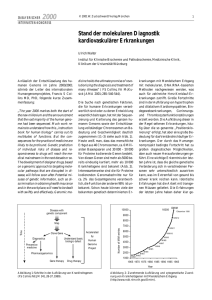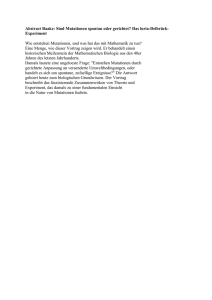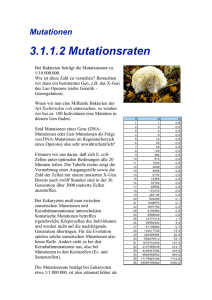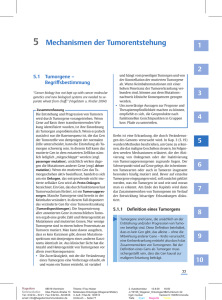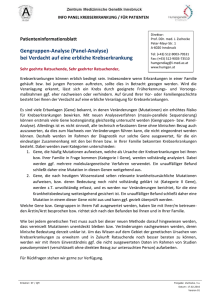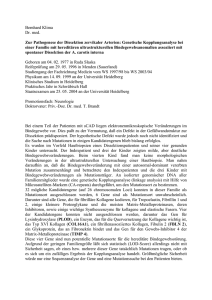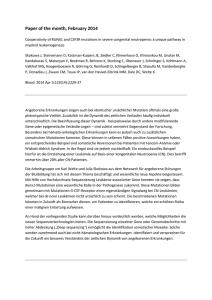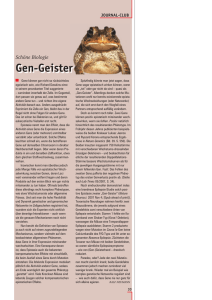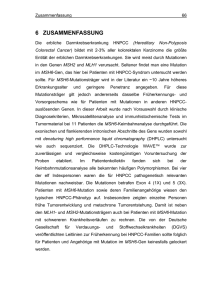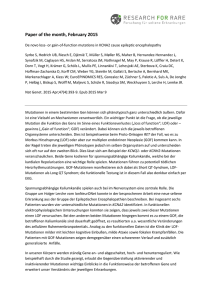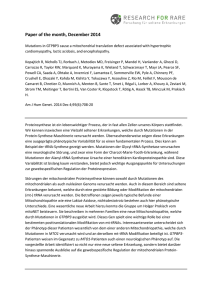Paper of the month, March 2015
Werbung
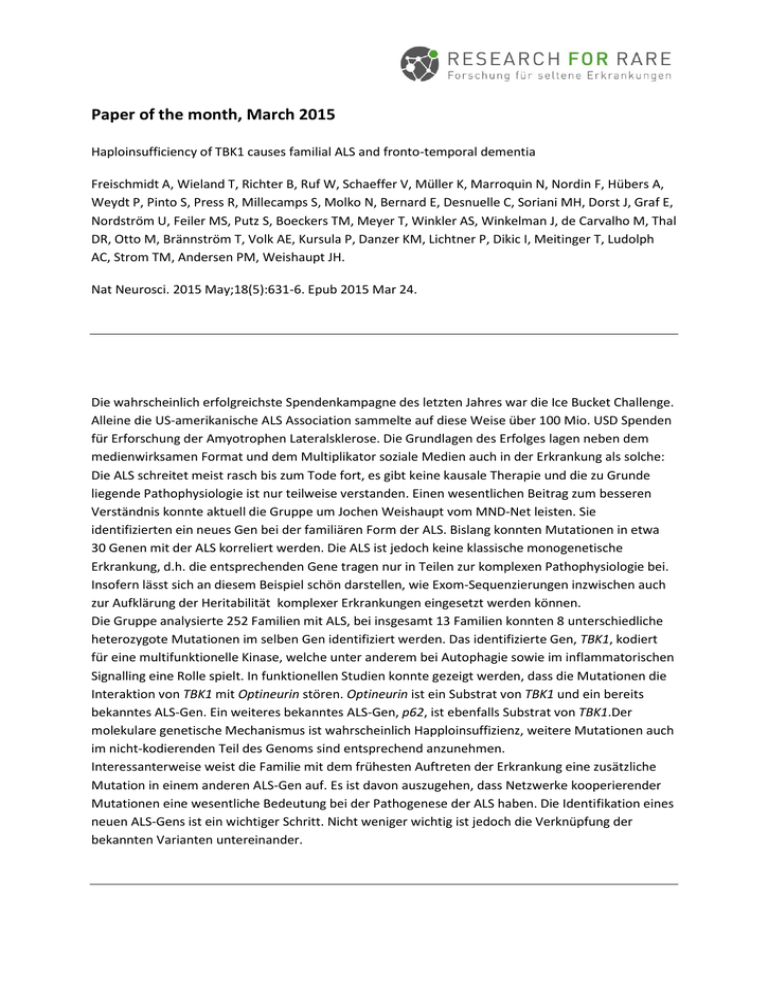
Paper of the month, March 2015 Haploinsufficiency of TBK1 causes familial ALS and fronto-temporal dementia Freischmidt A, Wieland T, Richter B, Ruf W, Schaeffer V, Müller K, Marroquin N, Nordin F, Hübers A, Weydt P, Pinto S, Press R, Millecamps S, Molko N, Bernard E, Desnuelle C, Soriani MH, Dorst J, Graf E, Nordström U, Feiler MS, Putz S, Boeckers TM, Meyer T, Winkler AS, Winkelman J, de Carvalho M, Thal DR, Otto M, Brännström T, Volk AE, Kursula P, Danzer KM, Lichtner P, Dikic I, Meitinger T, Ludolph AC, Strom TM, Andersen PM, Weishaupt JH. Nat Neurosci. 2015 May;18(5):631-6. Epub 2015 Mar 24. Die wahrscheinlich erfolgreichste Spendenkampagne des letzten Jahres war die Ice Bucket Challenge. Alleine die US-amerikanische ALS Association sammelte auf diese Weise über 100 Mio. USD Spenden für Erforschung der Amyotrophen Lateralsklerose. Die Grundlagen des Erfolges lagen neben dem medienwirksamen Format und dem Multiplikator soziale Medien auch in der Erkrankung als solche: Die ALS schreitet meist rasch bis zum Tode fort, es gibt keine kausale Therapie und die zu Grunde liegende Pathophysiologie ist nur teilweise verstanden. Einen wesentlichen Beitrag zum besseren Verständnis konnte aktuell die Gruppe um Jochen Weishaupt vom MND-Net leisten. Sie identifizierten ein neues Gen bei der familiären Form der ALS. Bislang konnten Mutationen in etwa 30 Genen mit der ALS korreliert werden. Die ALS ist jedoch keine klassische monogenetische Erkrankung, d.h. die entsprechenden Gene tragen nur in Teilen zur komplexen Pathophysiologie bei. Insofern lässt sich an diesem Beispiel schön darstellen, wie Exom-Sequenzierungen inzwischen auch zur Aufklärung der Heritabilität komplexer Erkrankungen eingesetzt werden können. Die Gruppe analysierte 252 Familien mit ALS, bei insgesamt 13 Familien konnten 8 unterschiedliche heterozygote Mutationen im selben Gen identifiziert werden. Das identifizierte Gen, TBK1, kodiert für eine multifunktionelle Kinase, welche unter anderem bei Autophagie sowie im inflammatorischen Signalling eine Rolle spielt. In funktionellen Studien konnte gezeigt werden, dass die Mutationen die Interaktion von TBK1 mit Optineurin stören. Optineurin ist ein Substrat von TBK1 und ein bereits bekanntes ALS-Gen. Ein weiteres bekanntes ALS-Gen, p62, ist ebenfalls Substrat von TBK1.Der molekulare genetische Mechanismus ist wahrscheinlich Happloinsuffizienz, weitere Mutationen auch im nicht-kodierenden Teil des Genoms sind entsprechend anzunehmen. Interessanterweise weist die Familie mit dem frühesten Auftreten der Erkrankung eine zusätzliche Mutation in einem anderen ALS-Gen auf. Es ist davon auszugehen, dass Netzwerke kooperierender Mutationen eine wesentliche Bedeutung bei der Pathogenese der ALS haben. Die Identifikation eines neuen ALS-Gens ist ein wichtiger Schritt. Nicht weniger wichtig ist jedoch die Verknüpfung der bekannten Varianten untereinander. Probably last year’s most successful fundraising campaign was the ice bucket challenge. The USbased ALS Association alone gathered donation of around 100 million USD for research on amyotrophic lateral sclerosis. The campaign’s success was facilitated by its media-effective format and multiplier effects of social media such as facebook, but also by the nature of the disease itself: ALS usually progresses rapidly to death, there is no causal therapy and the underlying pathophysiology is only partially understood. Very recently, the group around Jochen Weishaupt from MND-Net recently made a significant contribution to a better understanding of the disease. They identified a new gene causing familial ALS. To date, mutations in about 30 genes have been associated with ALS. However, the ALS is not a classical monogenic disease, i.e. the corresponding genes contribute only partially to the complex pathophysiology. Therefore, the present work is a nice example of how how exome sequencing can also be used to investigate the heritability of complex diseases. The group analyzed 252 families with ALS and identified a gene with 8 different mutations in 13 of these families. The identified gene, TBK1, encodes a multifunctional kinase that plays a role both in autophagy and in inflammatory signaling. In functional studies they demonstrated that these mutations disrupt the interaction of TBK1 with Optineurin. Optineurin is known to mutate in other ALS families - just like p62, another substrate of TBK1. The molecular genetic mechanism is predicted to be happloinsufficiency. This suggests that there might be more currently unidentified mutations also in the non-coding part of the genome. Interestingly, the family with the earliest disease onset had an additional mutation in a different ALS gene. This points to the role of networks of cooperating mutations in the pathogenesis of ALS. The identification of a new ALS gene is an important step. No less important, however, is the decipherment of the cooperation between known variants. Comment by Dr. Tilmann Schober, Dr. von Hauner Children’s Hospital, Ludwig Maximilians University Munich [email protected]
